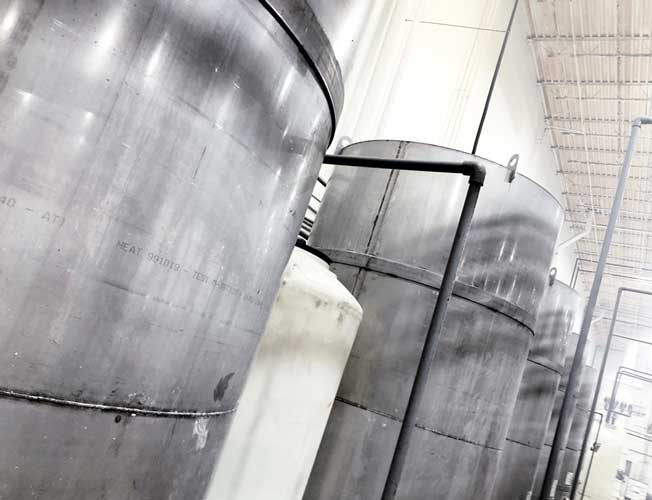
When it comes to the protection and longevity of metal parts, especially those subjected to harsh environments like oil and gas pipelines, the right coating solution can make all the difference. Coating the interior surfaces of metal pipes, steel tubes, and pump assemblies is best done in an immersion bath. This process offers several advantages that set it apart from other coating techniques.
Why Electroless Nickel Coating is Ideal for Interior Surfaces
Immersing metal parts in an electroless nickel bath is particularly well-suited for coating the interior surfaces of pipes, tubes, and assembled components due to the uniformity of the coating. Unlike traditional electroplating, which relies on an electric current for depositing the coating, electroless nickel plating is an autocatalytic process, meaning the chemical reaction occurs uniformly across all surfaces, regardless of their shape or size. This results in an even layer of protection that reaches into the most intricate recesses of the component, making it ideal for complex interior surfaces.
Pipes, steel tubes, and pump assemblies used in the oil and gas industry require this level of precision. The interior of these components is often exposed to corrosive chemicals, extreme temperatures, and high pressures. Electroless nickel coating often provides the necessary protection to prolong the life of most metal parts, reducing maintenance costs and preventing downtime due to component failure.
Electroless Nickel Coating in the Oil and Gas Industry
The extraction and delivery of petrochemicals from oil and gas fields present some of the harshest environments imaginable. Pipes and exposed metal parts used in this industry are subjected to corrosive chemicals, abrasive materials, and high-pressure conditions that can quickly degrade unprotected metal surfaces. This is where electroless nickel coating proves invaluable.
By applying a uniform, protective layer of nickel alloy on all metal parts used in the extraction and transport of petrochemicals, the oil and gas industry can extend the service life of equipment. This not only improves efficiency but also reduces the need for frequent replacements and repairs, ultimately saving time and money.
Metal coaters in Dallas and across Texas offer specialized oil and gas pipeline coatings in TX, using electroless nickel to ensure that pipes, tubes, and other components can withstand these tough conditions. The ability to apply this coating evenly across all surfaces, including the interior dimensions, is one of the key reasons this autocatalytic immersion bath method is so effective in the oil and gas sector.
Key Considerations in the Coating Process
When determining the right formulation for an electroless nickel baths, metal coaters must take into account several factors that influence the coating's performance. Corrosion protection is often the primary concern, especially for components used in industries like oil and gas, where metal parts are frequently exposed to harsh chemicals. The proportion of nickel and phosphorus in the coating bath is critical for providing this corrosion resistance.
In addition to corrosion protection, the coating’s ability to reduce friction and improve lubricity is also important. Components like pump assemblies and pipelines benefit from a low-friction surface that reduces wear and tear on moving parts and the flow of fluids. The inclusion of silicon carbide particles in the coating or PTFE can further enhance lubricity, making the components more durable in high-stress environments.
Lastly, boron can be added to the coating bath to enhance hardness and wear resistance. The specific proportions of nickel, phosphorus, boron, and silicon carbide particles will depend on the unique requirements of the application. For example, oil and gas companies may need a coating that prioritizes corrosion protection, while other industries might focus more on friction reduction.
Factors Affecting the Quality of the Coating
Several factors influence the quality of the electroless nickel coating, including the temperature of the plating bath, the quality of the chemicals used, and the size of the plating tank. For a metal plating service near Dallas or any other location, maintaining precise control over these variables is crucial for ensuring a consistent, high-quality coating.
The plating bath’s water temperature plays a significant role in determining the deposition rate of the nickel alloy. Temperatures that are too low can result in a slow deposition, while temperatures that are too high can cause the coating to become brittle. Maintaining the correct temperature range ensures that the coating process proceeds efficiently and that the final product meets the necessary performance standards.
The quality of the chemicals used in the bath also impacts the overall effectiveness of the coating. Impurities in the chemicals can lead to defects in the coating, such as pitting or uneven coverage. Metal coaters who specialize in oil and gas pipeline coatings in TX take great care to ensure that the chemicals in their baths are of the highest quality.
Finally, the size of the plating tank determines whether the entire component can be submerged in the bath at one time. For large pipes and tubes, metal coaters may require oversized tanks to ensure that all surfaces, both interior and exterior, are coated evenly.
Electroless nickel coating for tubes offers a highly effective solution for protecting metal components from corrosion, friction, and wear. This coating method is especially beneficial for industries like oil and gas, where metal parts are exposed to harsh environments. By carefully controlling factors like bath composition, temperature, and chemical quality, metal coaters in Dallas and beyond can deliver reliable, long-lasting coatings that extend the life of critical equipment. For industries seeking durable, high-quality coatings, electroless nickel is an excellent choice, providing comprehensive protection and enhanced performance across all surfaces, including the interiors of complex components.